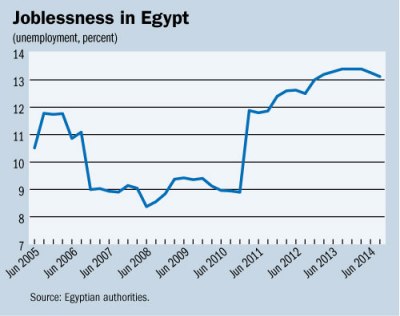How can Egypt stablise its economy and boost living standards?

Stay up to date:
Egypt
Egypt currently faces what may seem to be conflicting objectives. On the one hand, there’s an urgent need to restore economic stability—by achieving lower budget deficits, public debt and inflation, and adequate foreign exchange reserves. At the same time, there’s a long-standing need to achieve better standards of living—with more jobs, less poverty, and better health and education systems—one of the key reasons why people took to the streets in 2011.
Some might think that those two goals don’t go together—that the actions needed to reduce the budget and external deficits will necessarily take away from jobs and growth. But that’s not true. Some of the same policies that will improve Egypt’s financial situation can also help improve living standards.
A difficult starting point
A call for a fairer access to economic opportunities, especially jobs, was one of the key reasons behind the January 2011 revolution. However, the past four years of political transition have taken a toll on the economy. As a result, chronic economic problems were left unaddressed and new problems became acute.
The overall fiscal deficit rose from 9.8 percent of GDP in fiscal year 2010/11 to 13.8 percent in 2013/14. As a result, general government debt—domestic and external—increased from 76.6 percent of GDP to 90.5 percent during the same period. The 2013/14 data show that reserves in the central bank fell short of covering three months worth of imports while average inflation stood at 10 percent.
At 2.2 percent in 2013/14, economic growth was too low to improve vital socioeconomic indicators. Unemployment peaked at 13.4 percent, with the highest levels found among youth and women. Poverty rose to 26.3 percent the year before, with another 20 percent of the population estimated to be close to the poverty line.
Of note, low growth, high unemployment and poverty in Egypt live alongside weaknesses in the structure of the economy that largely predate 2011. These stem mainly from inefficient systems of subsidies, cumbersome business regulations, low human capital, poor infrastructure, low access to finance, and poor external competitiveness.
Policies to raise growth and lower deficits: subsidy reform, exchange rate flexibility
In 2013/14, Egypt spent over 6 percent of its GDP on fuel subsidies—more than on health or education. Ironically, fuel subsidies tend to benefit the well-off segments of the population—think owners of gas guzzling cars—more than the poor who need more social protection, and better health and school systems.
Fuel subsidies also favor capital-intensive industries whereas Egypt needs more labor-intensive industries to help reduce unemployment. Moreover, they contribute to large fiscal deficits and rising public debt and, hence, economic fragility, leaving very little to spend on infrastructure.
Subsidy reform, which is part of the economic policy package the Egyptian authorities have already started implementing last summer, can change these distortions. By increasing fuel prices, the government will be able to generate large savings. This will make room for more transfers to the vulnerable people, and more resources to improve the living conditions of the poor, together with investment in roads, schools, hospitals, and power plants. This is front and center in the authorities’ agenda, and the authorities have already started designing a conditional cash transfer system, financed in part by the savings stemming from the fuel subsidies reform.
Spending more on health, education, and infrastructure will not only help the poor and most vulnerable groups in the short term, but it could also help generate higher potential growth in the longer term. This, as research shows, is very important for job creation and better standards of living.
Another key economic policy is exchange rate flexibility. A more flexible exchange rate can strengthen competitiveness, attract foreign investment and tourism, and support exports of new industries. These can create jobs and support long-term growth and hence, raise living standards. Against this backdrop, the recent movement of the exchange rate of the Egyptian pound against the U.S. dollar is a step in the right direction.
Structural reforms are crucial
Structural measures to improve the business environment that can make Egypt a more attractive place for investors will be important. For instance, according to the World Bank, it takes 218 days to get a construction permit in Egypt, compared to only 29 days in the Republic of Korea. Dismantling inefficient regulations and red tape will be essential to increase investment and spur jobs. Progress in this area would also help bring the informal economic sector into the fold, with a positive impact on unemployment and standards of living at large. We have found the Egyptian authorities well aware of the urgent need for structural reforms, and current plans to issue a revised investment law, for instance, go in the right direction.
A key challenge for the government is building modern and transparent institutions to encourage accountability and good governance, and ensure fair and transparent rules of the game. Fairness in economic policy can ensure that the gains of growth can benefit all people in the society. It can ensure evenhandedness in access to jobs and opportunities for businesses, whether people are connected or not.
Also, there are steps that policymakers can take to make the financial system work better. For example, only 10 percent of Egyptians currently have bank accounts. Increasing the diffusion of financial services and extending more credit to small job-creating businesses could help the economy in a big way. Again, progress is happening in this area in Egypt, with the adoption of a micro-finance law which could help develop the financial sector.
Finally, improving the educational system is of paramount importance for Egypt’s long-term development. Jobs cannot be created without aligning the education system to prepare graduates for what is needed in the modern labor market. The rebalancing of spending towards health and education mandated by the constitution, if implemented efficiently, could support higher, more inclusive growth in the longer term while preserving fiscal sustainability.
With the right policies, Egypt’s government can meet the hopes and aspirations of the Egyptian people. Steadfast implementation of reforms can help restore economic stability, and spur jobs and growth. For its part, the IMF remains committed to helping Egypt achieve better living standards.
This article is published in collaboration with IMF Direct. Publication does not imply endorsement of views by the World Economic Forum.
To keep up with the Agenda subscribe to our weekly newsletter.
Author: Chris Jarvis is the mission chief for Egypt and an Advisor at the International Monetary Fund’s Middle East and Central Asia Department.
Image: Cairo is seen during a sandstorm, in this general view taken February 11, 2015. REUTERS/Asmaa Waguih.
Don't miss any update on this topic
Create a free account and access your personalized content collection with our latest publications and analyses.
License and Republishing
World Economic Forum articles may be republished in accordance with the Creative Commons Attribution-NonCommercial-NoDerivatives 4.0 International Public License, and in accordance with our Terms of Use.
The views expressed in this article are those of the author alone and not the World Economic Forum.
Forum Stories newsletter
Bringing you weekly curated insights and analysis on the global issues that matter.
More on Economic GrowthSee all
Naoko Tochibayashi
July 30, 2025
Matt Watters
July 29, 2025
David Elliott
July 28, 2025
Michael Wang
July 28, 2025
Ivan Shkvarun
July 25, 2025
John Letzing
July 24, 2025






